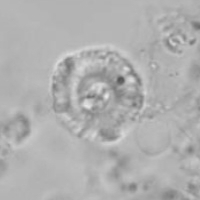Markalius astroporus
Set number: 496
-
1
-
2
-
3
-
4
-
5
-
6
-
7
-
8
-
9
-
10
-
11
-
12
-
13
-
14
-
15
-
16
10µm
In mobile mount
Cyclococcolithus astroporus Stradner, 1963
Cyclococcolithus leptoporus subsp. inversus Deflandre in Deflandre & Fert, 1954
Markalius walvisensis Bernaola & Monechi, 2007
Re-photo of holotype by Stradner et al., 2010
Circular to subcircular species of Markalius with a closed central area that can be circular to elliptical and a spaced proximal shield.
In cross-polarised light (with the gypsum plate inserted), the blue interference patterns are aligned to the horizontal axis on the distal side in the tube cycle (Plate 1, Figs. 10, 22 in Varol, 2023). In contrast, the tube cycle shows the blue interference patterns aligned with the vertical axis on the proximal side (Plate 1, Figs. 12, 24 in Varol, 2023). This feature helps to identify it from Carlamuelleria in plan view. The shields of Markalius astroporus display an opposite interference pattern to that of the tube cycle on the distal side (Plate 1, Figs. 12, 24 in Varol, 2023) and the proximal side (Plate 1, Figs. 12, 24 in Varol, 2024). This feature helps to identify this species from Davidbukrya in plan view.
ICN states in Art. 11.2. “A name has no priority outside the rank in which it is published (but see Art. 53.4)”. Therefore, the species Cyclococcolithus astroporus has priority over the subspecies Cyclococcolithus leptoporus subsp. inversus because it was published before the latter subspecies was amended into species rank.
In the side view, Markalius astroporus is easily distinguished from Davidbukrya, Carlamuelleria, Noelia and Senelia by having a proximal shield that is spaced from the distal shield. In contrast, Davidbukrya has no shields; Carlamuelleria has a vestigial, diminutive proximal shield; and Noelia and Senelia have appressed proximal shields.
Bernaola, G. & Monechi, S. 2007. Calcareous nannofossil extinction and survivorship across the Cretaceous_Paleogene boundary at Walvis Ridge (ODP Hole 1262C, South Atlantic Ocean). Palaeogeography Palaeoclimatology Palaeoecology. 255: 132-156.
Hay, W. W., Mohler, H. P., Roth, P. H., Schmidt, R. R. & Boudreaux, J. E. 1967. Calcareous nannoplankton zonation of the Cenozoic of the Gulf Coast and Caribbean-Antillean area, and transoceanic correlation. - Transactions of the Gulf-Coast Association of Geological Societies 17: 428-480.
Stradner, H. 1963. New contributions to Mesozoic stratigraphy by means of nannofossils. Proceedings of the Sixth World Petroleum Congress. Section 1 Paper 4: 167-183.
Stradner, H., Aubry, M. -P., Bonnemaison, M. 2010. Calcareous nannofossil type specimens in the collection of the Geological Survey of Austria: A taxonomic and stratigraphic update. Jahrbuch der Geologischen Bundesanstalt 150(1-2): 9-84.

